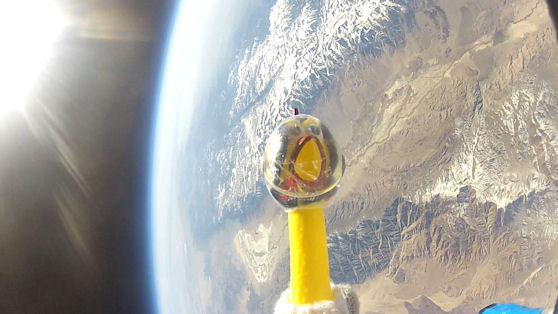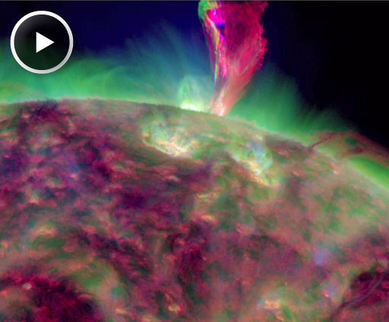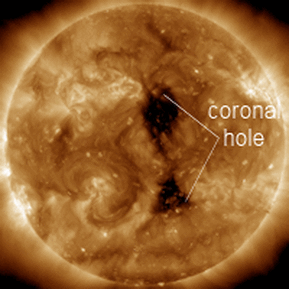www.spaceweather.com
|
The brightest planet in the solar system is reaching its peak luminosity. On April 30th, Venus will shine at astronomical magnitude -4.7. That's 190 times brighter than a 1st magnitude star, bright enough to see in broad daylight if your eye lands right on it. You can find Venus by looking 40° (about four fist-widths) east of the sun. Observing tip: Stand in the shadow of a tall building. You can also wait until the sun goes down. Venus is terrifically brilliant in the western twilight.
www.spaceweather.com
0 Comments
“In their opinion, the year 2012 is a milestone of the old epoch and the beginning of something new, maybe the beginning of a new culture. And they emphasized that this would happen slowly and gradually without cataclysms and earthquakes,” Novoselsky said. “People living in the center of the Mayan civilization haven’t any panic about this prophecy.” He added, “In my opinion, all these prophecies are a chance to think about our behavior, the meaning of life, about how to improve yourself and other people’s life, and how to live in harmony.” – Epoch Times
http://theextinctionprotocol.wordpress.com/ April 23, 2012 – SPACE - Here’s troubling news in the world of astrophysics, in which astronomers can’t seem to find the dark matter. As you may know dark matter is a much-speculated upon, but unknown substance that cannot be seen but appears to exist as it exerts a gravitational force on material around it. Astronomers first posited the existence of dark matter to explain why the outer portions of galaxies rotate quickly, and it now is also an important part of theories that explain how galaxies form and grow. “This is an article that we are going to have to take seriously,” Texas A&M astronomer Nick Suntzeff told me. Which is to say that if dark matter is not where our theories predict it will be, our theories probably have some serious issues. –Chron Mystery of cosmic rays deepens: New evidence may now rule out gamma-ray bursts as sources of these. Using the IceCube Neutrino Observatory at the South Pole in Antarctica, the boffins watched 300 gamma-ray bursts (GRBs) while searching for the neutrinos that are believed to be linked with cosmic ray generation, and found none. “The unexpected absence of neutrinos from GRBs has forced a re-evaluation of the theory for production of cosmic rays and neutrinos in a GRB fireball and possibly the theory that high energy cosmic rays are generated in fireballs.” -Space, Register
http://theextinctionprotocol.wordpress.com/ On Sunday morning, April 22nd, just as the Lyrid meteor shower was dying down, a spectacular fireball exploded over California's Sierra Nevada mountain range. The loud explosion rattled homes from central California to Reno, Nevada, and beyond. According to Bill Cooke, head of NASA's Meteoroid Environment Office, the source of the blast was a meteoroid about the size of a minivan. "Elizabeth Silber at Western University has searched for infrasound signals from the explosion." says Cooke. "Infrasound is very low frequency sound which can travel great distances. There were strong signals at 2 stations, enabling a triangulation of the energy source at 37.6N, 120.5W. This is marked by a yellow flag in the map below."
Assuming this value for the speed, I get a mass for the meteor of around 70 metric tons. Hazarding a further guess at the density of 3 grams per cubic centimeter (solid rock), I calculate a size of about 3-4 meters, or about the size of a minivan."
"This meteor was probably not a Lyrid; without a trajectory I cannot rule out a Lyrid origin, but I think it likely that it was a background or sporadic meteor." www.spaceweather.com
April 19, 2012: Last month, when the sun unleashed the most intense radiation storm since 2003, peppering satellites with charged particles and igniting strong auroras around both poles, a group of high school students in Bishop, California, knew just what to do. They launched a rubber chicken.
Many space enthusiasts are already familiar with Camilla. She's the mascot of NASA's Solar Dynamics Observatory. With help from her keeper, Romeo Durscher of Stanford University, Camilla corresponds with more than 20,000 followers on Twitter, Facebook, and Google+, filling them in on the latest results from NASA's heliophysics missions.
Read the rest of the story at: http://science.nasa.gov/science-news/science-at-nasa/2012/19apr_camilla/
Since a quantum computer works with qubits, which can have values of 0, 1, or a quantum superposition of both, a quantum Internet would have to able to communicate in qubits. This prototype network accomplishes that by using photons to carry the information around. The team has managed to rig up a laser to fire and hit the first networked atom in a way that the atom preserves its quantum state, but also produces a photon with that information plastered onto it. The photon then shoots off down the fiber optic cable delivering it to the second atom. Network achieved.
On top of that, the researchers managed to get the two networked atoms to entangle, which means the network should be completely scalable to something along the lines of an Internet. The project’s lead researcher, Dr. Stephan Ritter said: “Entanglement of two systems separated by a large distance is a fascinating phenomenon in itself. However, it could also serve as a resource for the teleportation of quantum information. One day, this might not only make it possible to communicate quantum information over very large distances, but might enable an entire quantum internet.” Quantum computers will exponentially increase the power of computing as we know it, and now it looks like we might have a solid network to support them by the time they’re up in working order. The real question is which of these technologies will reach wide scale usability first. –Geek System
"Saturn is close to opposition and the rings are brightening. This is the Seeliger Effect," says Go. "Also a Northern Electrostatic Disturbance, which was detected by Cassini a few days ago, can be seen as a white patch north of the green belt."
Saturn is easy to find. Look south at midnight. The ringed planet forms a "double star" with Spica. [sky map] www.spaceweather.com
This is your new blog post. Click here and start typing, or drag in elements from the top bar.
|
QUICK INFO
Author:
_Messenger Spirit This section is for interesting items which are brought to my attention but which do not merit a separate article.
I welcome your comments, questions or suggestions on any topics you wish to contribute to this section. Please submit these on the Contact and Feedback Form PLEASE DO NOT SUBMIT COMMENTS ON THE FORM WHICH APPEARS UNDER ITEMS ON 'QUICK INFO'; THIS SYSTEM IS NOT WORKING. Categories
All
Archives
July 2024
|
















 RSS Feed
RSS Feed